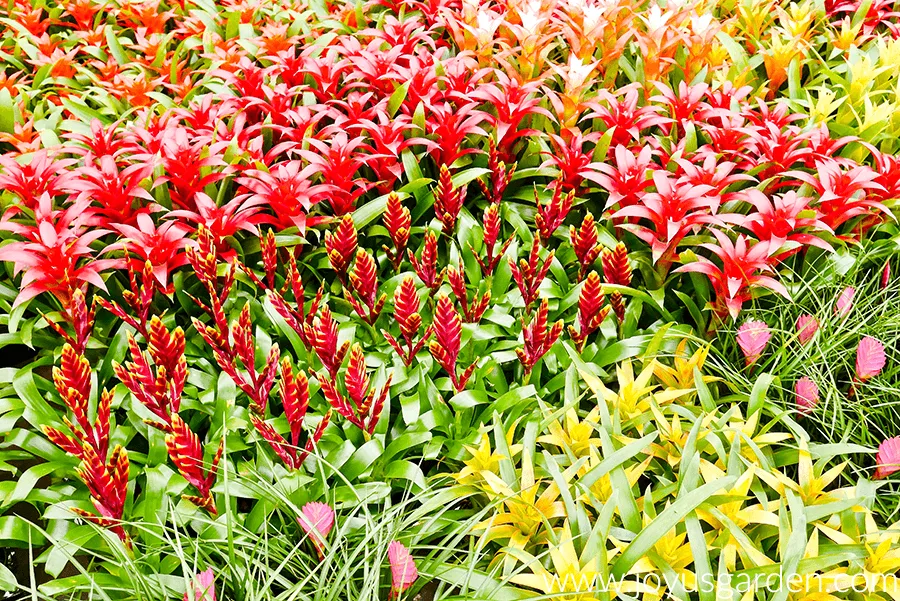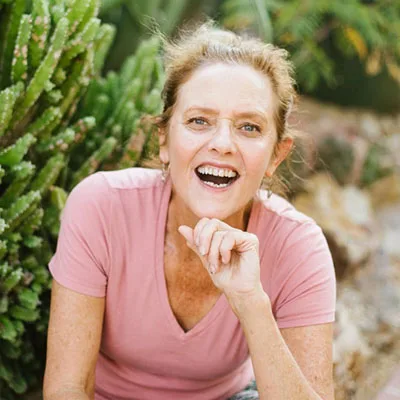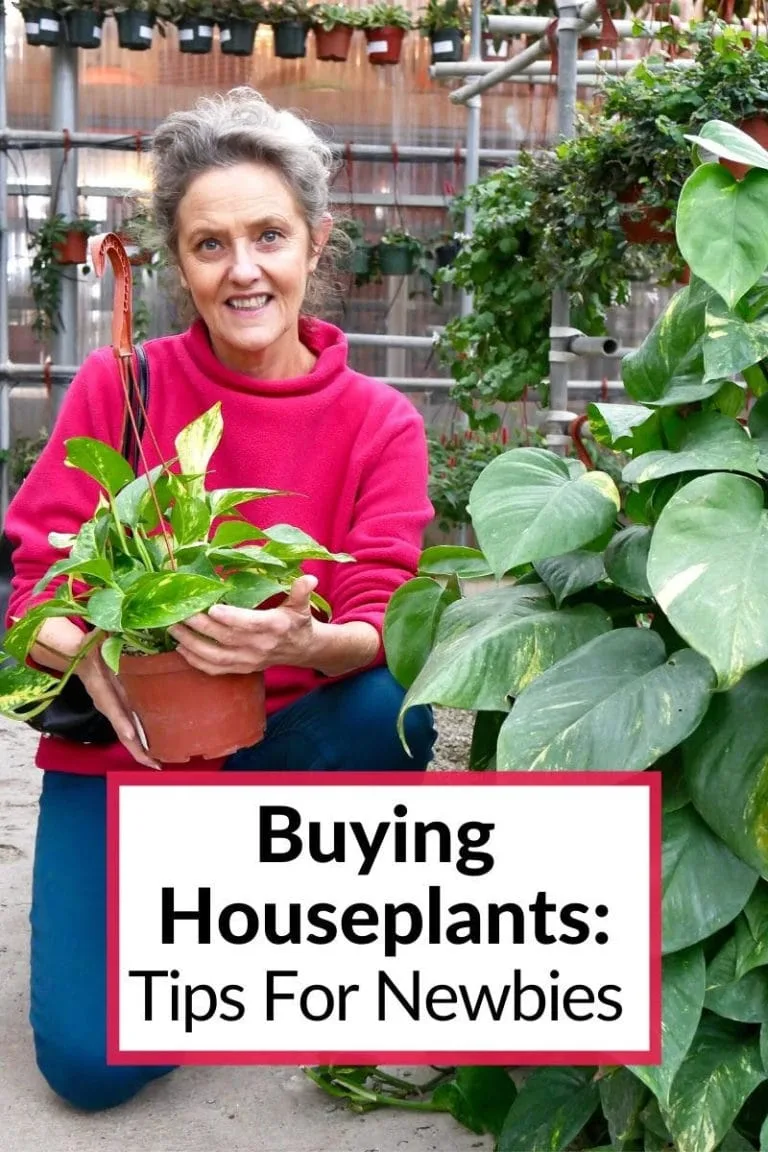A Guide To Watering Indoor Plants
Here’s the million-dollar question: how often should you water your indoor plants? There’s no definitive answer here because so many variables come into play. I’m going to answer questions and give you things to think about which will help you when it comes to watering indoor plants.
First off, I’ll fill you in on my education and experience so you know I’m a legit houseplant aficionado. I studied landscape architecture but ended up graduating with a degree in landscape and environmental horticulture. You can read all the details in this post about My Love Affair With Houseplants.
I was an interior landscaper (an interior plant specialist) for years, both maintaining and designing for commercial accounts. Suffice it to say I learned more on the job than in school. I’ve enjoyed plants in my own homes for many years now, so I’m happy to share what I’ve learned along the way.

How to Water Indoor Plants
So many variables and factors are involved that I can’t give you a set answer as to how often you should water your houseplants. For instance, I watered my houseplants in San Francisco and Santa Barbara differently than I do in Tucson where I now live.
Different plants have different needs. In my indoor plant care posts, I always give you an idea of how I water my houseplants so you can use that as a guideline. You can find them by searching for a specific plant on our site or browsing through our Houseplants Care section.
2 Most Common Reasons Houseplants Don’t Thrive
1.) Over watering or under watering. Too much water = no oxygen to the roots, leading to root rot. Not enough water and the roots dry out. Most beginning houseplant gardeners tend to water their plants too much, ie too often.
2.) Right plant wrong place. Specific plants have specific requirements. A Ficus benjamina won’t survive in low light and high light exposure next to a window could cause a Golden Pothos to sunburn.

What to Consider Before Watering Houseplants
Here are variables that come into play when determining a watering schedule. You should think about these things before and while watering your plants. Be sure to check the FAQs section towards the end for more info.
The Type of Plant
Different plants have different watering needs. This goes hand in hand with the point below. Tropical plants need watering more often than succulents.
Succulent needs are different from indoor plants. Here you can find helpful tips on watering them: A Guide To Watering Succulents Indoors

Different Plants Have Different Water Needs
I don’t water all of my many houseplants at 1 time. It would be much easier if I did, but some dry out faster than others, and some need watering more often than others. For instance, Peace Lilies will need watering more often than Snake Plants.

How You Water
Water the soil mass all around, not just in one spot. The roots run all around the base of the plant. I always top water my plants rather than bottom water them. And, don’t water too shallow ie, a splash every few days.
Check the Soil Before Watering
Water by how the soil feels. Most roots go deep and aren’t sitting close to the surface. Just because the top of the soil looks dry, it doesn’t mean the roots further on down are. If you’re unsure or just don’t want to stick your finger in the soil, use a moisture meter when watering large floor plants.
Exposure / Light The Plant Is In
This is simple. More light = more watering frequency. Less light = less watering frequency.
Pot Size / Type of Pot
The smaller the grow pot or pot, the more often your small plants will need watering. The larger the pot, the less often. Plants in larger pots don’t need watering as often as those in small pots.
And, plants in large pots aren’t any harder to water and in some cases can be easier because they don’t need it as often.
Terra cotta and clay pots, as well as unglazed pots, are porous, which means air can get into the root ball. Plants in these types may need watering a bit more often than those in plastic grow pots or directly planted in ceramics or resin pots.
It’s best if the pots have drainage holes so the excess water can flow out the bottom.

The Size Of The Root Ball
If the root ball is tight in the pot, it’ll most likely need watering more often. Some plants grow best when slightly tight in their pots. However, if they’re too potbound, the roots won’t be able to hold water.
The Soil Mix It’s Planted In
The heavier the soil mix, the less often you’ll water. I have a Dracanea marginata planted in potting soil sitting close to a Dracaena Lisa planted in lava rock (some larger houseplants will come planted in lava rock). I water the Lisa more often than I do the marginata. The lava rock doesn’t hold the water as potting soil does.
Top-Dressing
If the soil is top-dressed with moss, rock, or bark, then it’ll dry out slower.

Temperature
The warmer the temperature of your home, the faster your plants will dry out. I live in Tucson, Arizona where the temps are warm and the sun shines a lot. If you live in a cooler climate (most people do!) then you would water your indoor plants less often.
Humidity
The higher the humidity, the slower the mix will dry out (especially potting soil). I’m not only in a sunny and warm climate but the humidity is low so I water my plants more often.
Small brown leaf tips are due to dry air. Some of my plants have them, but many don’t.
The Water Quality
This doesn’t have to do with frequency, but tap water may be high in salts and minerals. These can cause the roots to burn, which will show up as brown tips and/or brown spots on the leaves. I have a tankless R/O water filtration system that runs through my kitchen faucet, and that’s the source I use to water my houseplants. It has a re-mineralization cartridge that puts the good minerals back in.

I’ll save this important point for last:
Time of Year
This is really important to know when it comes to watering indoor plants. Plants rest a bit in the cooler, darker months so you’ll water them less often. For instance, I water my 6″ Pink Aglaonema every 7-9 days in the summer whereas, in winter, it’s every 14 or so days.
Did you know that you need to change your watering habits in the winter? Here’s a helpful guide for watering in the colder months: Winter Houseplant Care Guide
What I Use For Watering Indoor Plants
I’ll keep this short and sweet. I use a small watering can for my smaller plants and a larger watering can I bought 5 years ago for my floor plants. I love a squeeze bottle for small plants in very small pots and a spray bottle for my Air Plants and other bromeliads. My friend has quite a few hanging plants and uses a device with a very long neck for watering her many hanging plants sans ladder.

Some Of Our General Houseplant Guides For Your Reference: Guide To Watering Indoor Plants, Beginner’s Guide To Repotting Plants, How to Clean Houseplants, Winter Houseplant Care Guide, Plant Humidity: How I Increase Humidity For Houseplants, Buying Houseplants: 14 Tips For Indoor Gardening Newbies
Watering Indoor Plants: Frequently Asked Questions
There’s no set answer for this. It varies from plant to plant, depending on your home environment, the size pot it’s in, the soil composition, and the time of year. All the above points and answers to these questions will help you out plus the individual care posts which you can find in our Houseplants Category.
Yes, watering your houseplants every day is too much.
I have always watered my indoor plants from the top and let the excess drain out. This method has always worked for me. If you water consistently from the bottom, there are two potential issues. Salts and minerals could build up in the bottom of the soil mix and the water may not absorb up high enough in the pot to reach all the roots.
This is the way that’s worked best for me: I water my indoor plants during daytime hours with room temperature water with a watering can or squeeze bottle (if the pots are very small).
It can be tricky to determine overwatering from underwatering. In both cases, the plant can show signs of wilting as well as pale or yellow leaves.
Here’s a general rule: if the plant is soft to the touchy (mushy) and you see brown spots on the leaves or portions of them turning dark, then it’s overwatering. Soggy soil over a prolonged period can lead to fungus gnats. If the leaves turn pale and/or look wrinkled, then it’s too dry. You might also see the soil pulling away from the grow pot.
In my experience, a plant can recover from underwatering better than overwatering.
It could. This depends on the type of plant and how long the roots have stayed waterlogged. Once you notice the damage to your plant, it’s often too late to save it.
When I worked in the interior plantscaping business many moons ago the main reason plants had to be replaced was due to overwatering. It depends on the conditions, the plant, and the soil mix but overwatering can mean a quick death for an indoor plant.
This is especially true if you water house plants with the same frequency in winter as in summer. When the temps cool and the daylight hours get shorter is a good time to back off on the watering frequency.
Overwatered plants can recover on their own if caught early on. In many cases, you’ll have to repot the plant into fresh dry soil to give it a chance for survival.
As I said above, you may not be able to. You can try repotting it into a fresh potting mix. Start by shaking off all the old, wet soil mix. You can then examine the roots. If too many of them aren’t damaged, then repot into the dry mix.
As to whether it’ll recover on its own depends on the type of plant and how long it’s been sitting in the saturated soil. The longer the roots stay saturated, the less chance for recovery there is.
water my plants by instinct. I’ve been doing it for so long that it’s 2nd nature for me. You might check into getting a houseplant watering calendar, journal, or app. This will help you keep track of when you last watered your plants and prevent overwatering.
I have no issues sticking my finger into the soil to test the moisture level. For my plants in larger pots, I use a meter as a gauge.
Just because the top of the soil is dry doesn’t mean the roots and soil down below are. You can stick your finger into the soil if you’re unsure, but that works with plants in smaller pots. I find a moisture meter to be useful for plants in large pots.
Your tap water may be just fine. It depends on the chlorine and mineral content of your water. Some people have to use distilled water or purified for this reason. The damage will appear as excessive brown tipping or brown spots on the leaves.
I have this tankless R/O filtration system because Tucson has hard water. It puts the good minerals back in the water, which benefits plants (and humans too!).
Room temperature water is best. The roots of houseplants don’t like it too cold or too hot.
A watering can with a long narrow spout helps with this. Get the spout as close to the soil as you can when watering. This will prevent soil and water from flying out of the pot. You don’t want to create a waterfall!
It’s best to have a saucer under the pot. A simple plastic saucer under that is fine if your houseplant is in a grow pot. Any type of pot or saucer on the floor, table, or any other surface can have condensation build-up, leaving marks. I use pot risers and/or thin cork mats under pots and baskets. I’ve also seen felt protectors with plastic bottoms which would work fine too.
It’s best for the plants if the pot has at least 1 drainage hole on the bottom of the pot and perhaps also on the sides of the pot so the water drains right out. It’s hard to regulate the watering if the pot has none. Drain holes prevent water from building up in the bottom of the pot, which causes the roots to stay too wet.
This post on Planting & Watering Succulents In Pots With No Drain Holes might interest you.
Back off on the watering frequency. Plants rest a bit in winter and don’t need watering as often. Know that you can easily overwater a houseplant in the cooler, darker months.
I’ve done a post and video dedicated to Winter Houseplant Care with key points for keeping your indoor plants alive in the darker, cooler months.
Unless it’s Lucky Bamboo, not a good idea. I soak my Air Plants for a few hours in a bowl half-filled with water twice a week here in dry Tucson.
The exception to this would be if your houseplants have dried out to the extreme, and you need to water them from the top as well as soak them from the bottom to revive them. I do that to my Peace Lily if it’s gone bone dry.
It depends on the type of plant, the pot size, the time of year, and your environmental conditions. As a generalization, it’s 7-24 days. Plants need water to thrive and grow, but too much water isn’t the solution either.
I water my houseplants in the morning or afternoon because that’s when it’s most convenient for me. And I don’t have to turn on all the lights to see the pots! Houseplants rest a bit at night, so for that reason, I leave them be.
It depends on the type of plant. Most of them like it, but do a little research first to make sure.
I take my smaller indoor plants to my kitchen sink and spray the leaves once or twice a month. As I said earlier, I live in the desert, so I believe this makes my plants feel so good. I do it in the morning or afternoon so the leaves have time to dry before I put them back. I take my larger plants to the shower or take them outside for a rain shower once or twice a year to clean off the foliage.
You have to be careful that the leaves of houseplants don’t stay wet for a prolonged period, as it could lead to mildew or fungal growth on the foliage. This is especially true in the winter months.
This is a loaded question! My answer is: get houseplants with low water requirements so you don’t have to water them too often. Self-watering containers would make it easier, but I’ve never grown houseplants in them for the long haul.
Options that I know of for watering plants, when you’re away, are self-watering containers, self-watering inserts, self-watering spikes, self-watering tubes, and self-watering globes. You can also check and see if there are any plant-sitting services in your area.
I water cautiously when watering my indoor hanging plants and use my smaller watering can with a long, narrow spout. I don’t want water to gush out because saucers can fill up fast.
Hanging basket drip pan saucers, as well as self-watering hanging baskets, are other options. If your plant is in a grow pot inside a hanging basket, plastic pot, or ceramic, you can simply place a plastic saucer underneath the grow pot.


Don’t be a “hit and run” waterer. Splashing a plant every 2 or 3 days is not how it likes to be watered. Most people overwater their indoor plants and kill them with kindness. I’ve always believed that it’s better to err on the side of less water than more water.
I love watering indoor plants, so it’s not a chore for me. Crazy plant devotee that I am, watering my houseplants is something I look forward to each time I do it.
Conclusion: To sum this all up, you’ll water your different types of plants at different times and different frequencies. This depends on the plant’s water requirements, pot size, time of year, soil composition, and the environmental conditions of your home. As you become more comfortable with your houseplants, you’ll determine their watering needs!
Happy indoor gardening,







Hi Nell. Your site is amazing, and you have great detailed information on plant care!
I have a Dracena Massageana with long, broad leaves. It’s our first winter and a few leaves are beginning to have brown dry tips. I’ve been advised to move it from the window and reduce watering but wouldn’t overwatering cause droopy leaves instead? I’m thinking of getting the water meter to be safe. Also while my window is large it’s north facing. Could also be the drier Toronto winter air.
Additionally, there is one long root sticking out of the pot. How can I stop the drying tips? Any pointers would be welcome.